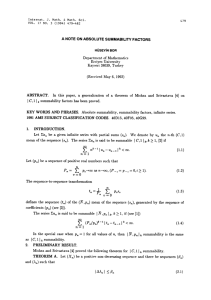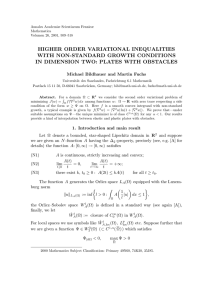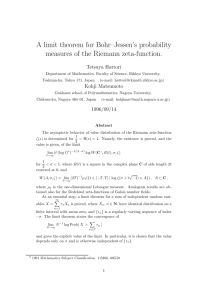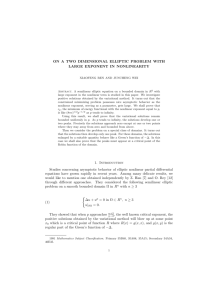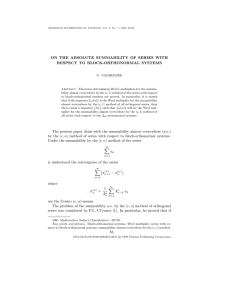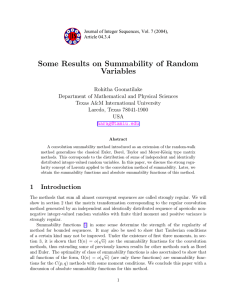A Tauberian theorem concerning weighted means and power series
advertisement
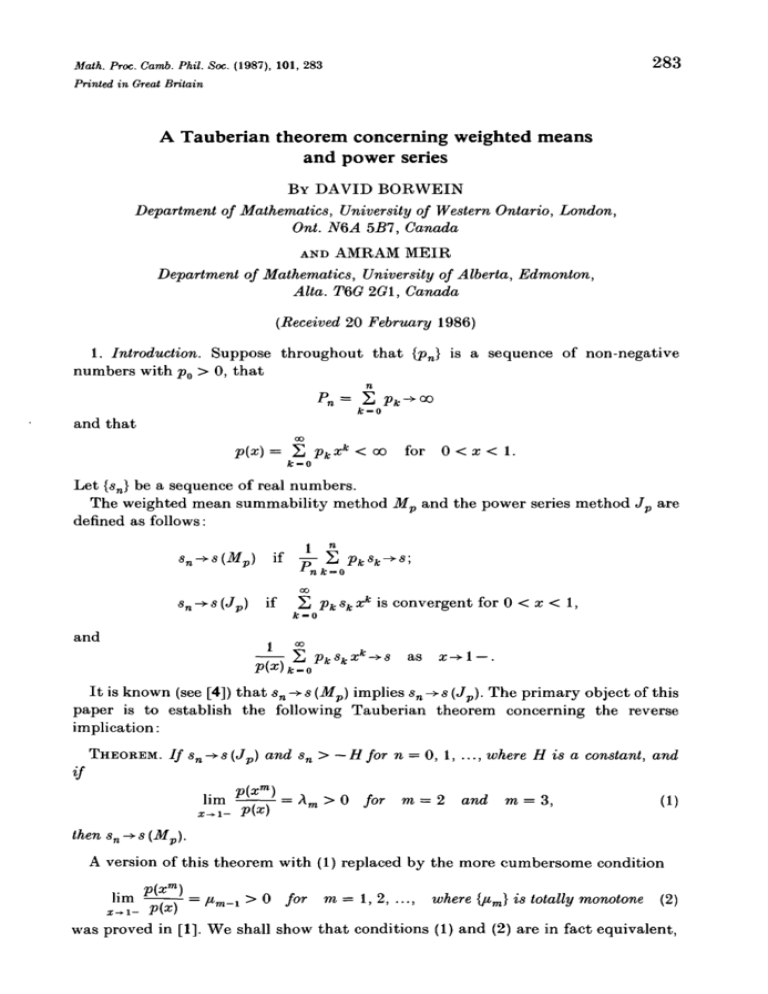
Math. Proc. Camb. Phil. Soc. (1987), 101, 283
283
Printed in Great Britain
A Tauberian theorem concerning weighted means
and power series
BY DAVID BORWEIN
Department of Mathematics, University of Western Ontario, London,
Ont. NQA 5B1, Canada
AND AMRAM MEIR
Department of Mathematics, University of Alberta, Edmonton,
Alta. T6G 2GI, Canada
(Received 20 February 1986)
1. Introduction. Suppose throughout that {pn} is a sequence of non-negative
numbers with p0 > 0, that
n
P
n=
2 Pfc-*^
fc-o
and that
00
p(x) = 2 Pkx>c < °°
f° r
0 < x < 1.
fc-0
Let {sn} be a sequence of real numbers.
The weighted mean summability method Mp and the power series method Jp are
defined as follows:
1 n
if — S
00
sn->s(Jp)
if
2 Pkskxk ' s convergent for 0 < x < 1,
fc-0
a n d
j
as
oo
It is known (see [4]) that sn^-s(Mp) implies sn^-s(Jp). The primary object of this
paper is to establish the following Tauberian theorem concerning the reverse
implication:
THEOREM.
/ / sn^-s(Jp)
if
and sn > —H for n = 0, 1, ..., where H is a constant, and
vixm\
\\m^-~-=\m>0
x^l-
P\x)
for
m = 2 and m = 3,
(1)
then sn^-s(Mp).
A version of this theorem with (1) replaced by the more cumbersome condition
f>(xm\
lim ——— = nm_i
x-iP\x)
> 0
for TO = 1 , 2 , . . . ,
where {jim} is totally monotone
(2)
was proved in [1]. We shall show that conditions (1) and (2) are in fact equivalent,
284
D A V I D B O R W E I N AND A M R A M M E I R
and that the sequence {jim} in (2) must necessarily have the form fim = (m+l)~p for
some p ^ 0. I t will also emerge that the integers 2, 3 in (1) can be replaced by any
two integers mlt m2 ^ 2 such that no power of the one is a power of the other (i.e.
\ogm1/\ogm2 is irrational). It is natural to ask whether
A
> 0
(3)
alone is equivalent to (1). It follows from the inequalities
pi^l^pifl^P^l
p(x)
p{x)
for
0<x<1)
p(x2) p{x)
that (1) and (3) are indeed equivalent in the special case when A = 1. We shall,
however, show that (1) and (3) are not equivalent when 0 < A < 1 by constructing
a function p(x) satisfying (3) for which p(x3)/p(x) does not tend to a limit as a;-*-1 —.
2. Proof of the theorem. We shall show that (1) implies (2) with/*m = (m+ l)~p for
some p ^ 0. Suppose (1) holds. For / > 0, define
A(0 = li
whenever the limit exists. It is readily verified that if A(t) and A(u) are defined and
positive, then A(tu) = A(t)A(u) and X(t/u) = A(t)/A(u). It therefore follows from (1)
that A(t) is defined throughout the set A of numbers t of the form t = 2? 3* with
j , k = 0, ± 1 , ± 2 ,
Since Iog2/log3 is irrational, it follows from Kronecker's
theorem ([3], theorem 439) that the sequence {n Iog2/log3} is dense modulo 1 in the
interval (0, 1) and hence that A is dense in (0, oo). Consequently, by lemma 1 on page
275 of [2], there is a finite p such that
A(t) = t~P for
teA.
Since A(t) is non-increasing in A we must have p ^ 0. Further, if u ^ t ^ v where
u, veA, then p(xv) ^ p(xl) ^ p{xu) for 0 < x < 1 and so
V-P
^ lim i n f ^ ^ ^ lim s u p ^ ^ ^ vT".
This implies that
A(t) = V
for all t > 0.
Our theorem thus follows from
Hence (2) holds with /im = (m+ l)~p for m = 0, 1
the second part of theorem 1 in [1], the proof of which can now be simplified since,
for p > 0,TO= 0, 1, ...,
-I
(m+\)-P=\
Jo
tmdX{t)
with
x(t)
=
l
\
\P)J o
Jo
and c in the proof can be taken to be any number in (0, 1).
I t is evident that the above proof works, mutatis mutandis, if the integers 2, 3 in
(1) are replaced by positive integers mx, mi such that log mjlogm2 is irrational.
A Tauberian theorem
285
3. Construction. We shall construct a function p(x) satisfying (3) for which
p(x3)/p(x) does not tend to a limit as »-> 1 —. We require the following lemma which
was proved in essence in [1].
LEMMA. If Pn+1 ~ Pn and limn^co(Pn/Pnm)
then limx^1_\p(xm)/p(x)] = A.
= A > 0 where m is a positive integer,
We first construct a sequence {an} of positive numbers converging to 0 such that
2n
lim S afc = 1
re->oo k = n
for which S | ^ , n % does not tend to a limit as w->oo. The construction is due to
E. F. Smet. Define a0 = 1,
ak = 2~m
2m^k<2m+1
for
(ra = 0, 1, ...)•
Then for any positive integer n we have n = 2m + r where 0 ^ r < 2m, so that
2n = 2m+1 + 2r < 2m+2 and hence
S
k=n
t
( 2
m
- r ) 2 - "
i
+ (2r+l)2-"l"1^l
as
n^oo.
On the other hand, for n = 2m we have
in
) "
1
^ |
as
m^oo,
whereas for n = 3-2 m-1 we have
3n
S
afc = (2 m + 2 -3-2 m )2- m - 1 + (9-2 m - 1 -2 r a + 2 +l)2- T O - 2 -^f
as m->oo.
k-2n
Thus Slig^ttj. does not tend to a limit as n->oo and consequently neither does
Now define a sequence {Pn} by setting Po = 1 and
n + i = -P»2a- for
n = 0,l
Then P ra+1 > Pn > 0, for n = 0, 1, ..., Pre-^oo and P re+1 ~ P n . Further
*••n
whereas
n
does not tend to a limit as w.->- oo.
Setting p0 = 1, p n = Pra — Pra_! for n = 1, 2, ..., we see from the lemma that
Suppose, contrary to what we wish to establish, that
hm ^—^ =
K.
286
D A V I D B O R W E I N AND AMBAM M E I R
Since
^
^
as
2
p(x) " p{x ) p(x)
4
it follows that K >m+1
0 and hence, by what was proved in §2 above,
p(x )
lim
—— = (m +1 )~p for some p > 0 and m = 0, 1, ....
x-*l—
It was shown on page 312 in [1] that this implies that, for 0 < c < 1,
P
fr-) -*y>0
p(c1/n
as ra^oo.
Therefore
—^
, ,/„,—>•- as
n->co.
This is a contradiction, and so the constructed p(x) satisfies (3) but p(x3)/p(x) does
not tend to a limit as a;-> 1 —.
Remarks. We have shown that (1) implies that
vix)
lim i-V-r = <~p for some p ^ 0 and all < > 0.
It follows from the theorem on page 276 in [2] that such a p(x) must necessarily be
of the form
p(x)=(l-x)-PL(x),
where L(x) is slowly varying in the sense that
lim ^ l = 1 for all t > 0.
A typical example of a slowly varying function is given by
L(x) = ( l o g j ^ j
with ft > 0.
Though we have shown that (3) does not imply (1), it is an open question whether
or not the theorem remains valid when (1) is replaced by (3) or even when (1) is
omitted altogether.
This research was supported in part by the Natural Sciences and Engineering
Research Council of Canada.
REFERENCES
[1] D. BORWEIN. Tauberian conditions for the equivalence of weighted mean and power series
methods of summability. Canad. Math. Bull. 24 (1981), 309-316.
[2] W. FELLER. An Introduction to Probability Theory and Its Applications, 2nd ed., vol. 2 (John
Wiley, 1971).
[3] G. H. HABDY and E. M. WRIGHT. An Introduction to the Theory of Numbers, 4th ed. (Oxford
University Press, 1960).
[4] K. ISHIGURO. A Tauberian theorem for (</, pn) summability. Proc. Japan Acad. 40 (1964),
807-812.








